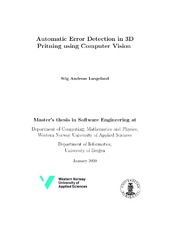Automatic Error Detection in 3D Pritning using Computer Vision
Master thesis
Permanent lenke
https://hdl.handle.net/1956/21450Utgivelsesdato
2020-02-01Metadata
Vis full innførselSamlinger
- Master theses [205]
Sammendrag
During recent years Additive Manufacturing Technology, or 3D Printing, has become extremely popular. 3D printing is being actively used in fields ranging from rapid prototyping and rapid manufacturing to Bio-printing for tissue manufacturing. However, it is a very time consuming process as a single object, depending on its size and complexity, may take from only a couple of hours to several days to print. In many cases, errors occurs in the middle of a printing process due to misalignment of the 3D printed object, slicing errors or blocked filament extrusion, causing a complete failure of the process. During longer printing processes such errors may occur several hours before we are able to detect them, and a lot of time and material are wasted. If we are able to detect these errors automatically as they occur we may be able to interrupt the process and save both time and material. Severe damage may be caused to a 3D printer if layers of material are continuously added to an object that is misaligned or has detached from the build plate. In this thesis we investigate the possibilities of using traditional Computer Vision algorithms and image processing techniques to automatically detect these errors as they occur. We built a prototype using two different camera angles to analyze both the first layer from a top-down view and the subsequent layers by placing the second camera in front of the build plate. In one of the modules developed in our prototype we managed to compare the 3D printed bottom layer with a simulation of the same layer to detect deviations from the CAD model.
